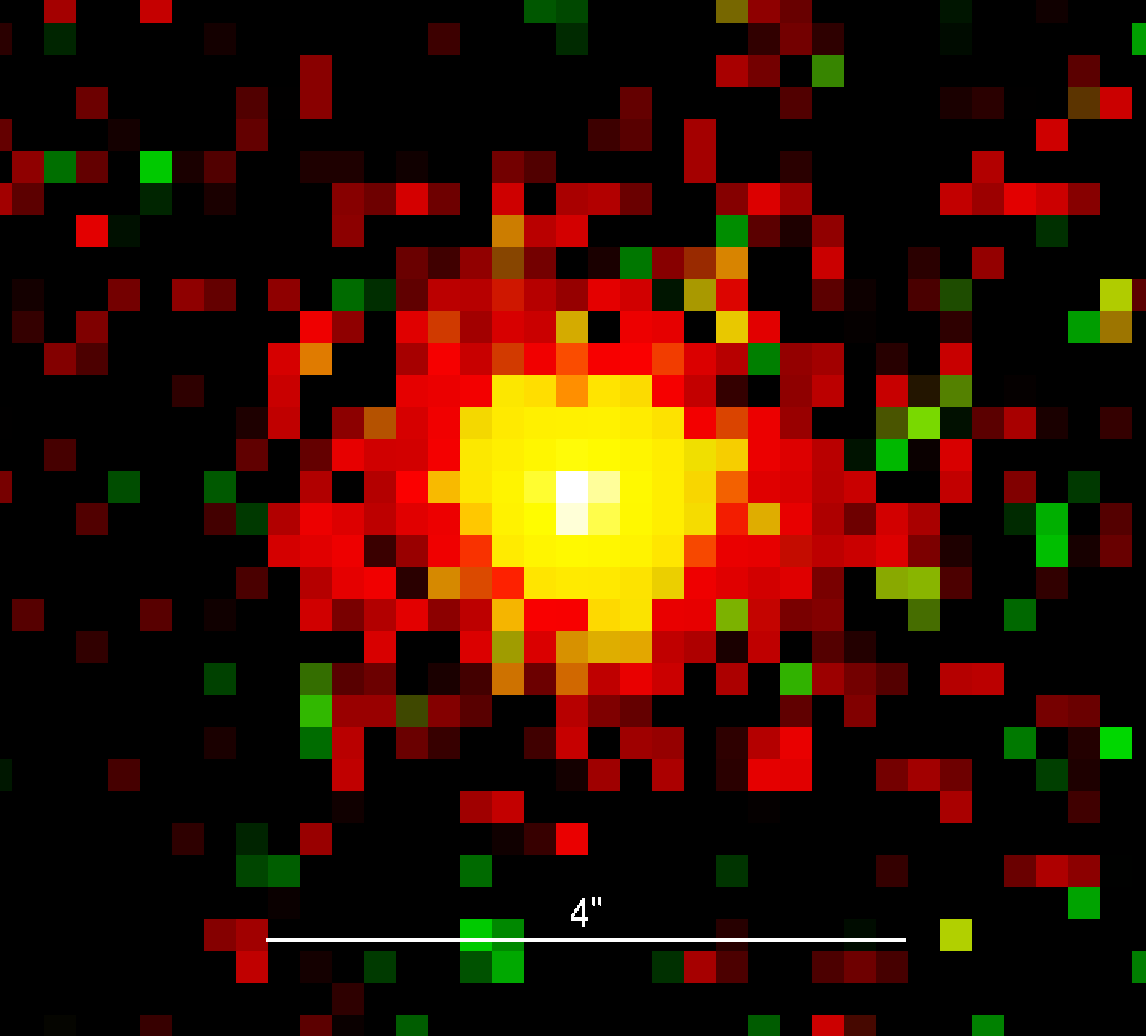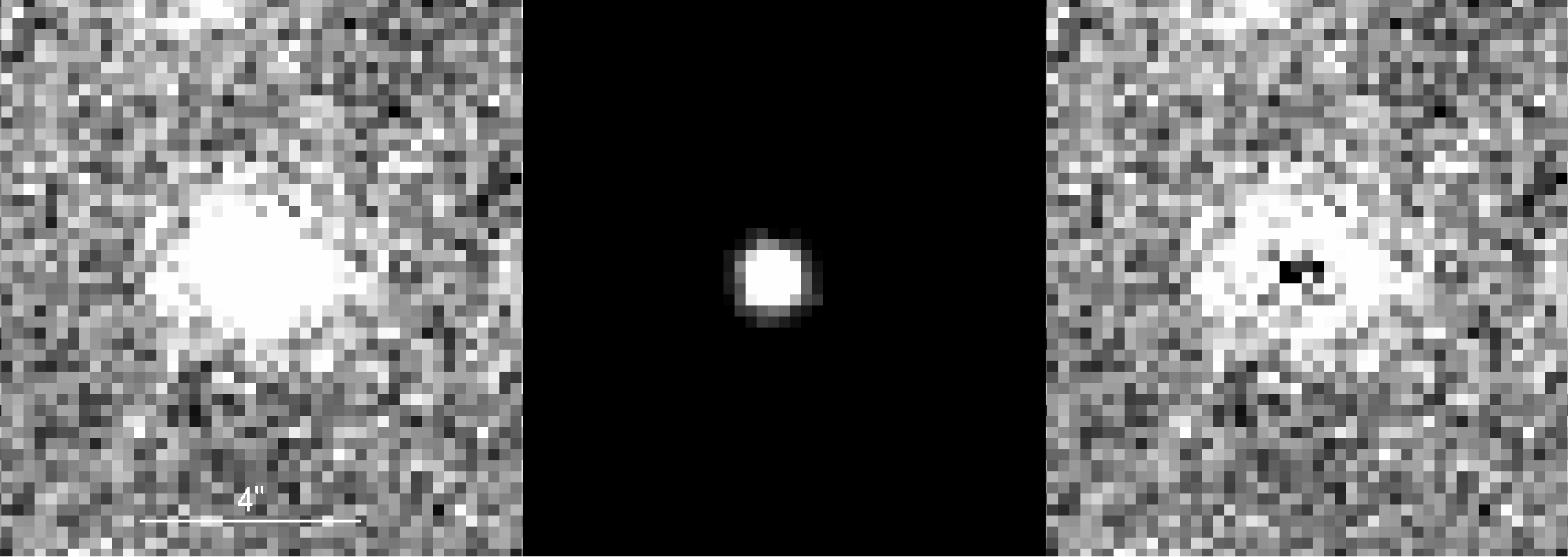
University of Hawaii astronomer Dr. Tomotsugu Goto and colleagues
have discovered a giant galaxy surrounding the most distant black
hole ever found. The galaxy, which is 12.8 billion light-years from
Earth, is as large as the Milky Way galaxy and harbors a
supermassive black hole that contains at least a billion times as
much matter as does our Sun.
Dr. Goto stated, "It is surprising that such a giant galaxy existed
when the Universe was only one-sixteenth of its present age, and that
it hosted a black hole one billion times more massive than the sun.
The galaxy and black hole must have formed very rapidly in the early
universe."
Knowledge of the host galaxies of supermassive black holes is
important in order to understand the long-standing mystery of how
galaxies and black holes have evolved together. Until now, studying
host galaxies in the distant universe has been extremely difficult
because the blinding bright light from the vicinity of the black hole
makes it more difficult to see the already faint light from the host
galaxy.
Unlike smaller black holes, which form when a large star dies, the
origin of the supermassive black holes remains an unsolved problem. A
currently favored model requires several intermediate black holes to
merge. The host galaxy discovered in this work provides a reservoir
of such intermediate black holes. After forming, supermassive black
holes often continue to grow because their gravity draws in matter
from surrounding objects. The energy released in this process
accounts for the bright light that these black holes produce.
To see the supermassive black hole, the team of scientists used new
red-sensitive CCDs installed in the Suprime-Cam camera on the Subaru
telescope on Mauna Kea. Prof. Satoshi Miyazaki of the National
Astronomical Observatory of Japan (NAOJ) is lead investigator for the
creation of the new CCDs and a collaborator on this project. He said,
"The improved sensitivity of the new CCDs has brought an exciting
discovery as its very first result."
A careful analysis of the colors revealed that 40 percent of light
around 9100Angstrom
is from the host galaxy itself and 60 percent is
from the surrounding ionized nebulae illuminated by the black hole.
Yousuke Utsumi (Graduate University for Advanced Studies /NAOJ), a
member of the project team,
said, "We have witnessed a supermassive black hole and its host
galaxy forming together. This discovery has opened a new window for
investigating galaxy-black hole co-evolution at the dawn of the
universe."
Dr. Goto is a fellow of the Japan Society for the Promotion of
Science (JSPS). He received his PhD from the University of Tokyo in
2003 and has also worked at Carnegie Mellon and Johns Hopkins
universities, and at the Institute of Space and Astronautical
Science, a part of JAXA, the Japanese equivalent of NASA. He came to
UH Institute for Astronomy in 2008 to work with Dr. David Sanders on
quasi-stellar objects (QSOs) and luminous infrared galaxies.
Other members of the research team are Dr. Hisanori Furusawa (NAOJ) and
Dr. Yutaka Komiyama (NAOJ).
This research will be published in the online version of the journal
Monthly Notices of the Royal Astronomical Society this month. The
paper is available at
http://www.ifa.hawaii.edu/~tomo/QSOhost/QSOhost_v7.pdf

Figure 1: False-color image of the QSO (CFHQSJ2329-0301), the most
distant black hole currently known. In addition to the bright central
black hole (white), the image shows the surrounding host galaxy
(red). (Tomotsugu GOTO, University of Hawaii)
The same figures in gif, png, tif.
The same figures without a caption, in gif, png, tif.

Figure 2: After a careful subtraction of the central light from the
black hole, the residual on the right panel shows a significant
detection of the host galaxy (16 sigma). The structure extends 4
arcseconds on the sky, or 22 kpc (72,000 light-years) wide, at z = 6.43.
(Tomotsugu GOTO, University of Hawaii)

Figure 2 with a caption in gif, png,tif. without a caption in gif, png, tif.
Research Team:
Tomotsugu Goto (JSPS SPD fellow,
Institute for Astronomy, University of Hawaii)
Yousuke Utsumi (The Graduate
University for Advanced Studies/National Astronomical Observatory of
Japan)
Hisanori Furusawa (National Astronomical Observatory of Japan)
Satoshi Miyazaki (National Astronomical Observatory of Japan)
Yutaka Komiyama (National Astronomical Observatory of Japan)